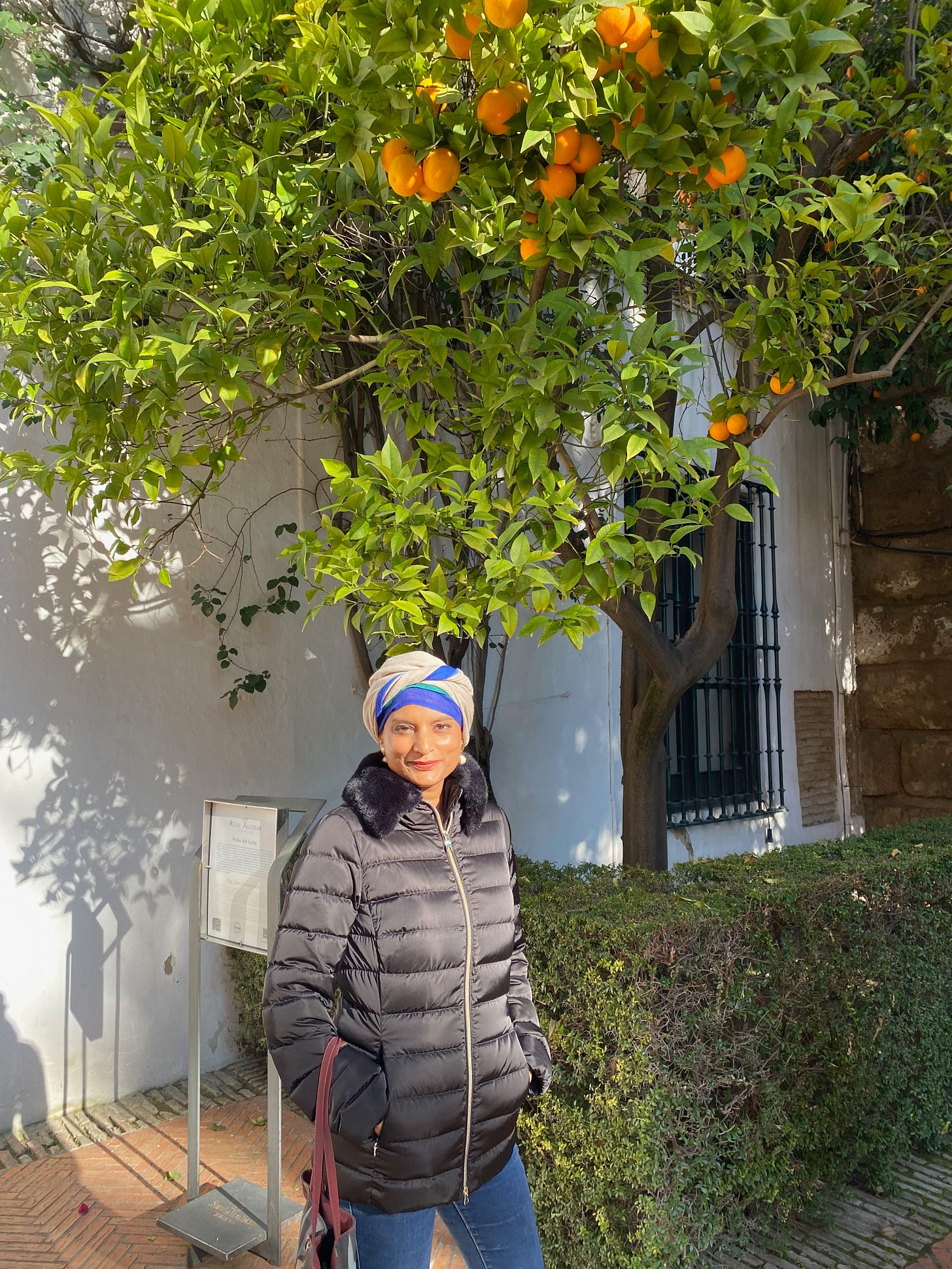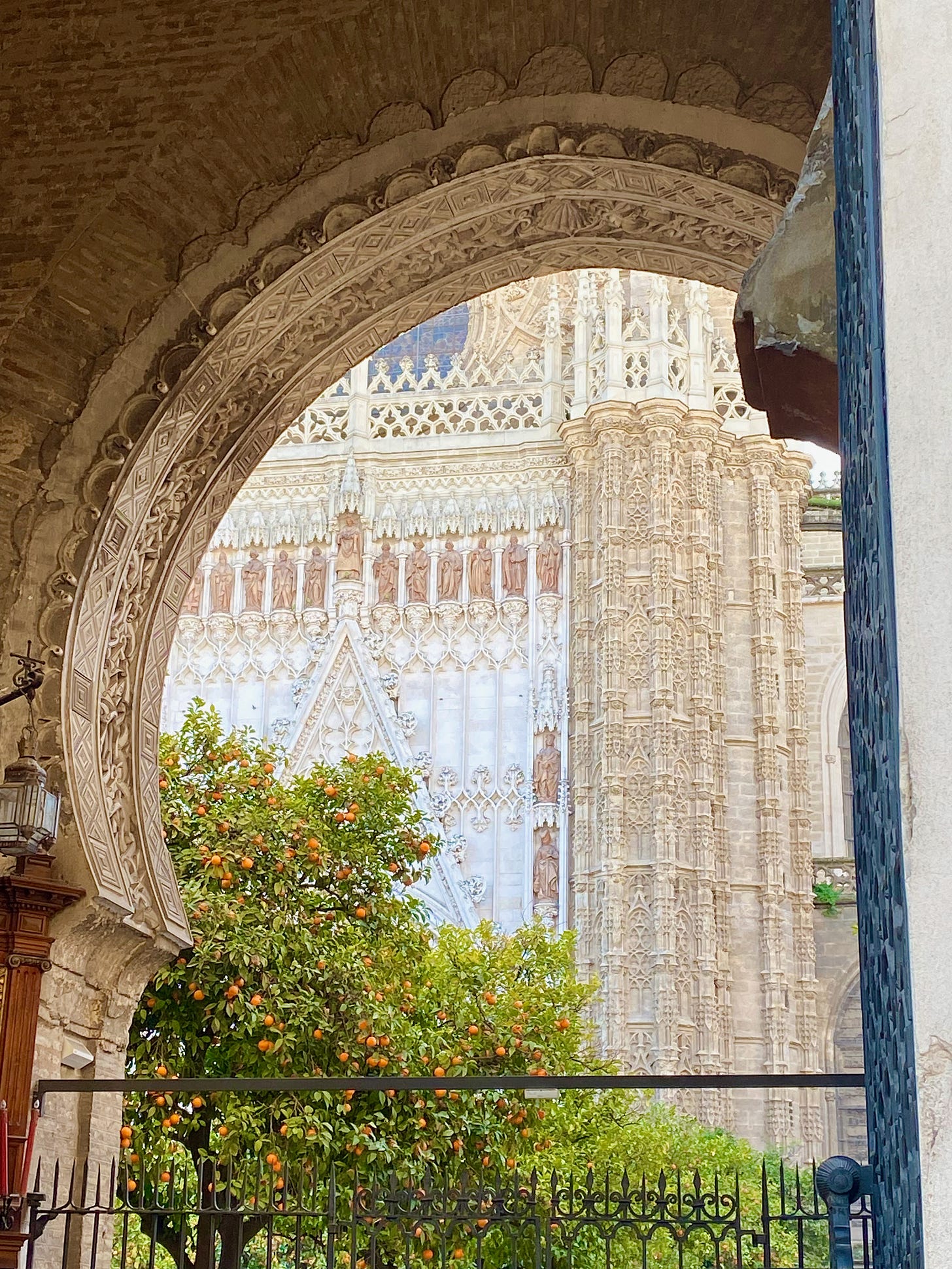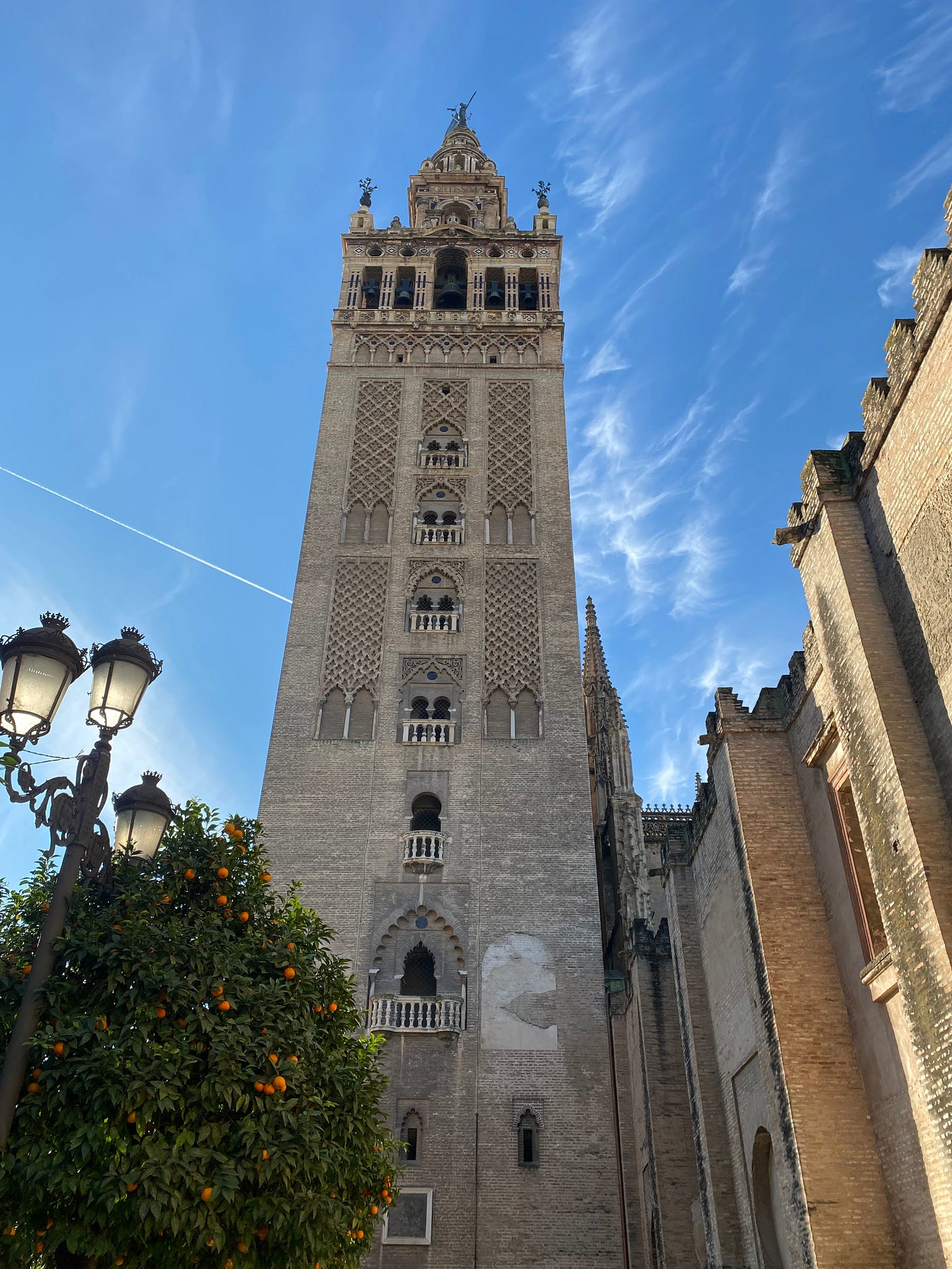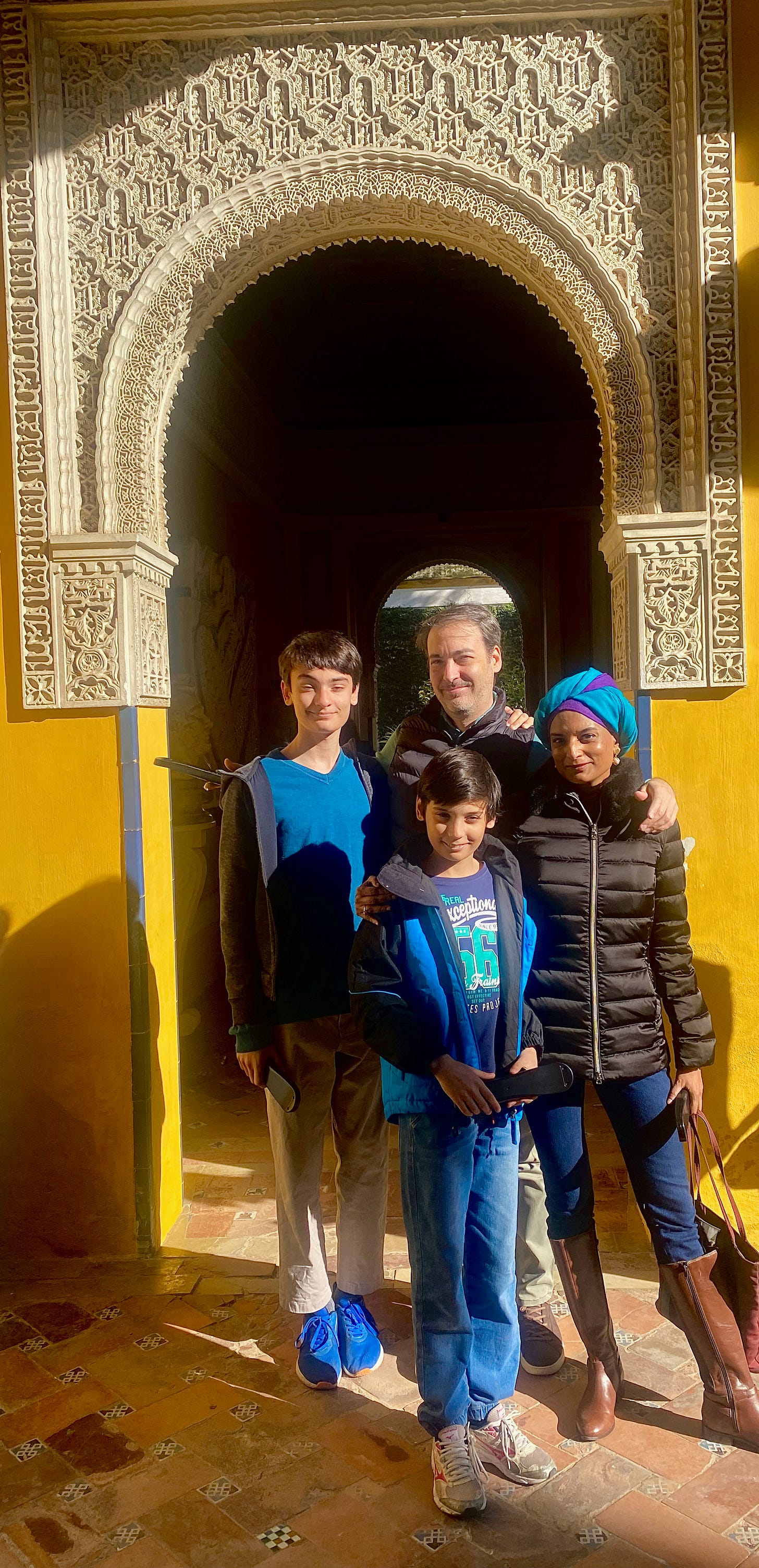Looking for Al Andalus in Seville
When a majoritarian atmosphere takes hold in a society, no concession is ever enough.
Hola Global Jigsaw Family,
Straight to the meat of today’s post, inspired by a trip we made to Seville two weeks ago to celebrate the end of the more toxic chemo drugs I was on and the switch to a less emetic regime.
Hope you find it thought provoking. Do share any thoughts.
LIVING IN SPAIN, as I do, is to know a dual reality: one that is both mongrel and purged. The Iberian peninsula’s history is simultaneously draped in shape-shifting syncretism and corseted by mono-religious strictures. It is a country of churches on mosques, on synagogues, on churches. And ultimately, it is a country cut off from itself, mysterious to itself.
I was in the city of Seville earlier in January. There, as in the other great centres of what was once known as Al-Andalus—the area of Spain ruled by Muslims for roughly 700 years between the 8th and 15th centuries—the sense of being somewhere porous was physically palpable. The orange trees that punctuate the cityscape, scented the air with the Orient. The quality of the sunlight spoke of warmer climes. The keening of Flamenco with its Middle Eastern-Central Asian-Indian-Silk Roadness was ubiquitous.
Orange trees are ubiquitous in Seville
We visited the Cathedral of Seville, one of the largest in the world. Like much else in Spain, it was built on the bones of a 12th century Almohad Mosque, destroyed by ‘reconquering’ Christians in 1433. The Almohad was a North African, Berber, Muslim dynasty that came to control Al-Andalus by the 1170s.
Seville Cathedral
We walked up the Giralda, the cathedral’s minaret-belfry, and the most obvious example of stylistic mélange. Originally built as a minaret in the 12th century, a Renaissance-style bell tower was grafted onto it in the second half of the 16th century. And thus it still stands today, an Islamic-Christian tower that rears up into the city’s sky, a spectral reminder of a Spain that is no more.
That the minaret wasn’t destroyed, but built upon, is an architectural manifestation of the decision to allow a polyphonic history to exist rather than one that is solely the story of ‘winners’. But even this apparent act of edificial generosity was firmly hierarchical. The Giralda is crested by the sculpture of a woman, triumphantly carrying a flagpole, a symbol of Christianity, lest there be any doubt about who came out on top.
The Giralda
But, as the food, language and architecture of even contemporary Spain reveals, the erasure of multicultural Spain—a rich, if often warring, confluence of Islamic, Jewish and Christian ways of life—was a slow process of self-mutilation.
Typically, Christian rulers did not immediately expel Muslims from the lands they conquered, but allowed them to remain, just as Christians and Jews had lived under Islamic rule as recognised minorities earlier. These latter Christians were called Musta’ribun, Mozárabe in Spanish and Mozarab in English. In Arabic, it simply means ‘Arabised’ Christians with a taste for the foods, scents and style of the Arabs.
The Mozarab community retained Latin as its liturgical language and was bilingual in Arabic and Spanish. Jewish communities in Al-Andalus were also substantial. And often received favourable treatment under Muslim rule, rising to high offices in the political and intellectual spheres.
But what is easily forgotten when talking about Islamic Spain is that most of the Muslims in the country were converts, not ethnically distinct foreigners, ‘Moors’ or ‘Arabs’. A majority of Spanish Muslims were as European as the Christians.
Inside the Seville cathedral, we visited the tomb of King Ferdinand III, the Christian conqueror of the city. It was inscribed, in the four languages of medieval Spain— Hebrew, Arabic, Latin and Castilian. The spirit of the early days of Spain’s Christian reconquest was to assimilate rather than expel. The new Christian rulers, steeped as they had been in Islamic culture, commissioned buildings in what is known as the Mudejar style.
Family picture in front of an arch in the Mudejar style
Drawn from the Arabic term, mudajjan, meaning “permitted to remain”—the word refers to both the Muslim peoples who chose to stay on in cities under Christian rule and the syncretic architectural style that continued to be popular even among Christian rulers.
After the fall of Granada, the last bastion of Al-Andalus, to Christian monarchs in 1492, intolerance towards non- Catholic peoples sharpened, with the Mudejar increasingly having to choose between baptism or expulsion. In February 1502, a decree was announced, expelling all those who refused to convert. The converted Mudejars of Spain were now nuevos Cristianos convertidos de moros, a term eventually shortened to ‘Moriscos’.
But even that proved not to be good enough in the newly mono-religious Spain. Islam and Judaism began to be treated like a bacillus whose infection was incurable, even by conversion. Forced conversions are naturally suspect. And certainly, a large number of Moriscos remained faithful to Islam in private while observing the externals of their new religion. Enter the Inquisition, a body established by the state to ferret out secret Jews and Muslims from under their outward Christian presentation.
By the time of the rule of Philip II (1556-98), the ‘problem’ of the Moriscos was complicated by increased geopolitical activity by the Ottomans, who threatened to destroy Spain’s Mediterranean fleet. There was a suspicion that the Moriscos’ true loyalty was towards their Muslim brethren rather than their Iberian compatriots. There was indeed evidence of widespread contact between the Moriscos of Granada and Morocco and Turkey. Furthermore, raids by pirates from the Barbary Coast (along North Africa) on the coasts of Valencia and Granada became increasingly common in the second half of the 16th century.
Philip issued a decree in 1567, that in effect eliminated all forms of Morisco identity: language, dress, literature, dances, rites. They had to leave their doors open on Fridays and feast days; even Moorish names had to be dropped. And unlike earlier, this decree was vigorously enforced.
By the beginning of the 17th century, the vast majority of Moriscos had been expelled to North Africa, bringing an end to centuries of cross-cultural pollination. No amount of historical memory of shared lives and culture, of the little moments of intimacy of which there must have been countless numbers, could save these once- Muslim Spaniards from the demands for purity. When a majoritarian atmosphere takes hold in a society, as it had in Spain, no concession is ever enough. And so, from the ashes of hundreds of years of multi-religious, multilingual clash and comingling, emerged a homogenous creation that served as the basis for modern Spain.
Today, you are likely to find Spaniards who claim a greater affinity to Buddhist new-age meditation than anything Islamic—which has become, as in much of the West, wholly ‘other’. The past here is largely seen as a series of Catholic kings, followed by the dictatorship of General Franco, and ending in the country’s membership of the European Union.
And yet, for those with the eyes to see, to live in Spain even today, is to live a heavily Islamic-influenced life. As an Indian, listening to Flamenco, eating the rice dish paella, or visiting national architectural treasures like the cathedral in Seville, is to be constantly aware of an absence; one that remains opaque to most Spaniards themselves.
I learned that ‘ojala’, which means ‘hopefully’ in Spanish, has its root in Insh’allah. So that every time a Spaniard says something akin to, “hopefully, we’ll meet soon”, unbeknownst to them, they are invoking the grace of God (Allah). There are 4,000 loan words from Arabic in Spanish.
The most prominent ingredient of paella, contender for the national dish, was introduced to the Iberian Peninsula by Arabs (the Spanish word for rice, ‘arroz’, is derived from the Arabic ‘arruzz’), as was the key spice of saffron.
The forgetting of the past in Spain is probably both accidental and wilful. Memory is artifice as much as fact. And history is a byproduct of this dual amnesia and constructed recollection. But there is a universal lesson here. We inhabit a world of cultural clash, certainties, pieties, and orthodoxies, when in fact the history of the world has been one of mélange, borrowings, and porousness.
*****
A reminder before signing off to upgrade to a paid subscription or to gift a subscription to someone you think might enjoy the Global Jigsaw. A gift of words and ideas makes the world a better place :-)
Until next week,
Pallavi
This piece was first published in Open Magazine here.








Beautifully written Pallavi. Entire history encapsulated in your article 🙏🏼
Great article Pallavi, thank you!
Yes Al Andalus left its magic imprint in modern Andalucia, which we owe to the Damascus Caliphate, a very advanced and refined society, far more so than its western contemporaries. It also left an imprint on our character ....You might want to look into this in a another post.
While the take over of most of Spain by the caliphate was fast and largely bloodless, a small but hard headed group of christians in the nortwest decided Islam was´nt for them, and decided to fight the invaders. The reconquista brewed todays Spain, until recently fanatically christian, always ready to fight "the moors., and to spread roman chistianity all over the world. A form of spiritual reconquista waged by succesice kings which undoubtebly protected indian americans from the greed of our conquistadores., but brought ruin to much of Europe, ruining Spain in the process